
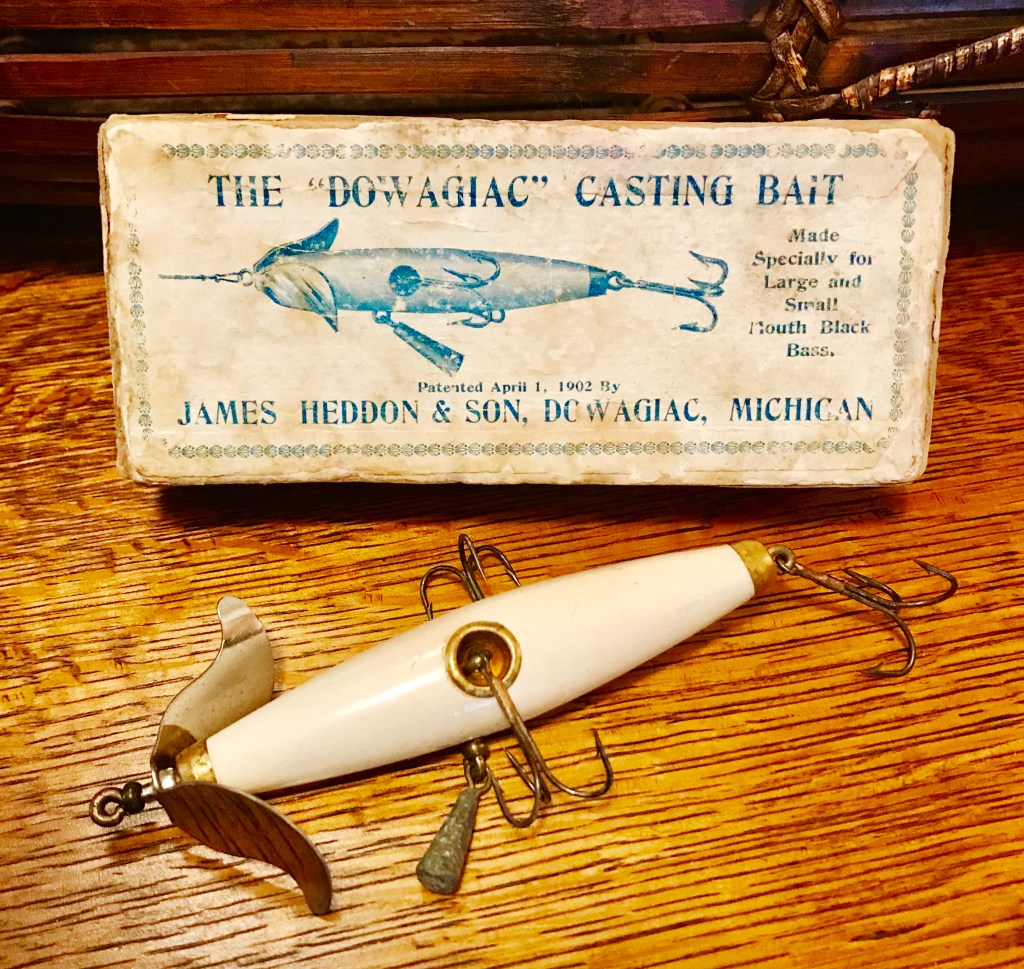
Referred to by collectors as the “Underwater,” this ultra-rare lure is among James Heddon’s earliest offerings. It was introduced in 1902 — the last year of the external, hanging belly weight. The following year, the company changed to an internal weight system, which became the standard for decades to follow. Rarer than the lure is the correctly designated picture box.
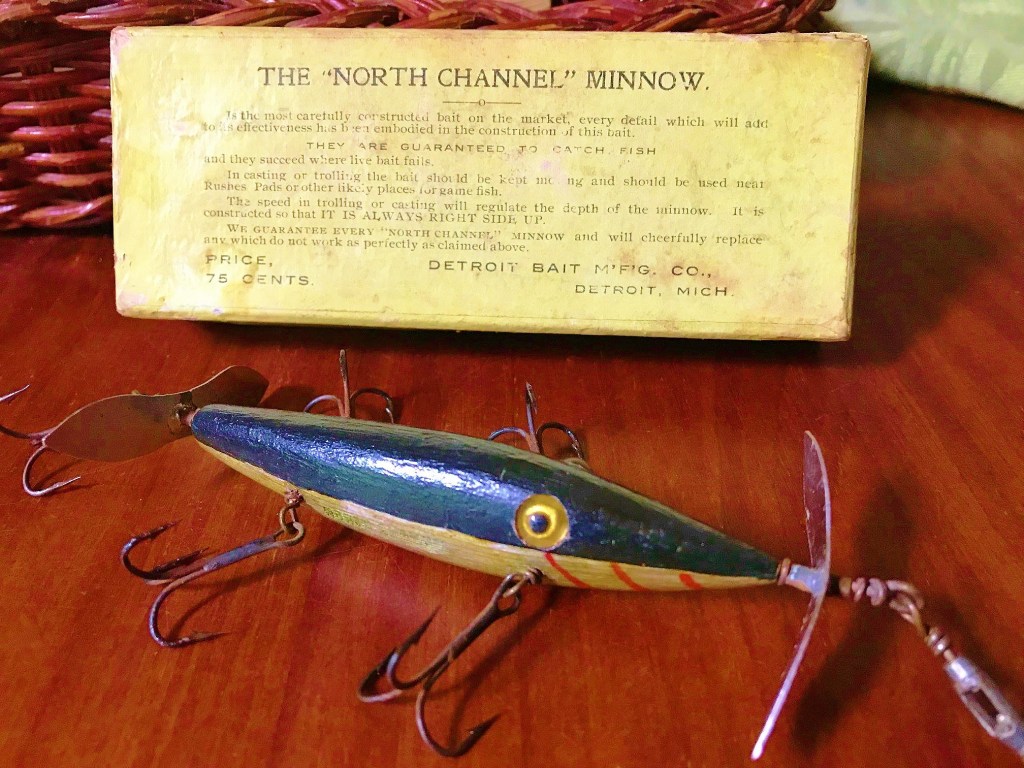
This early lure was named after the northern most channel of the St. Clair River, where it enters Lake St. Clair — a popular tour stop on the Bassmaster Elite Series. Somewhat crudely finished, they were introduced in 1903 by the Detroit Bait Manufacturing Company of Detroit, Mich.
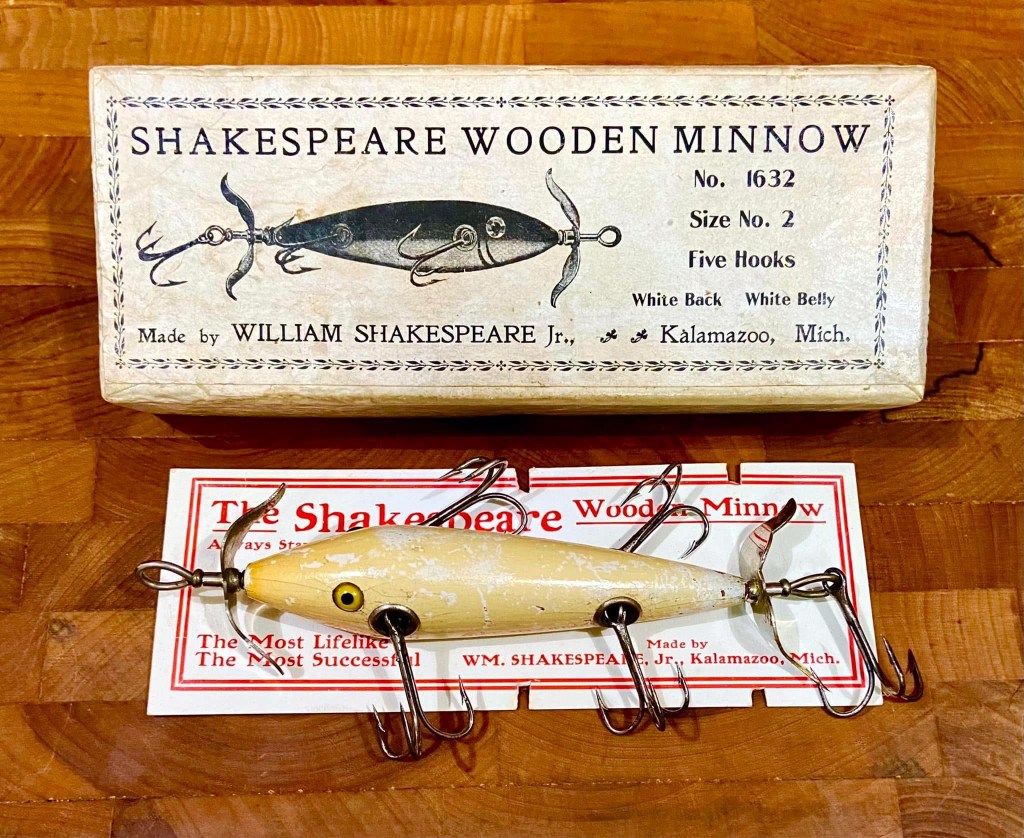
This attractive lure was presented by the William Shakespeare Jr. Company in 1906. As the box label indicates, the lure was originally referenced using a four-digit numeric code. But that soon changed to the two-digit (No. 44) designation. The lure, box and card are correct for each other and are rarely found complete.

Introduced in 1910 by the Charmer Minnow Company of Springfield, Missouri, these unique “barber pole” lures feature two-piece wooden bodies, large German-silver props, glass eyes and three sets of treble hooks. When retrieved through the water, the tail section spins, creating a visually attractive target for unsuspecting predators. Available in multiple color combinations, each was packaged in a color-matching box.
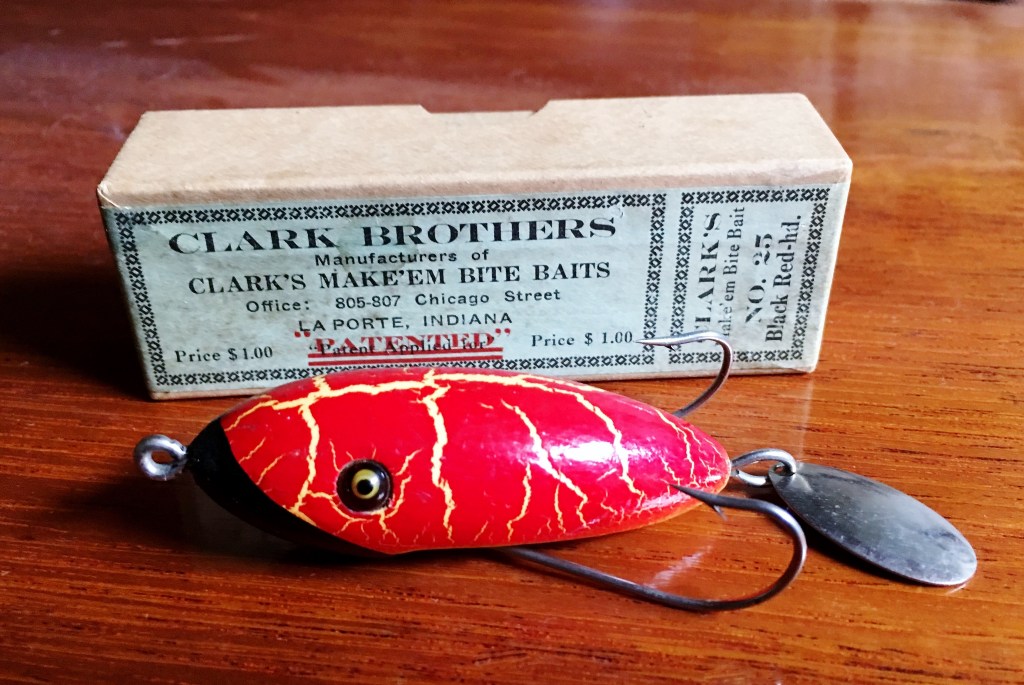
Featuring some of the best “crackleback” paint finishes of their time, these circa-1920s chunk baits have an appeal all their own. They were produced by Clark Brothers Bait Company of La Porte, Ind., and are considered quite rare … especially when accompanied by a correctly marked box.
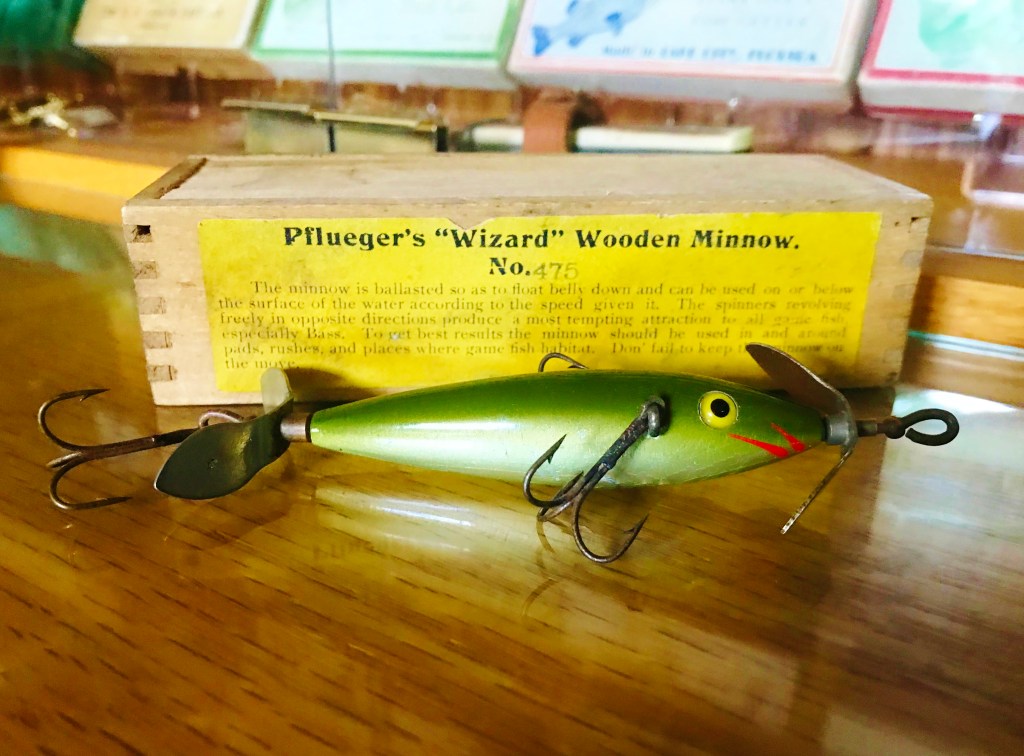
These sleek wooden minnows were introduced prior to 1907 and were available in three- and five-hook configurations. The props and yoke-colored glass eyes on this example are indicative of its age, as is its one-way, slide-top wooden box.
According to the side label, the Wizard Minnow was “ballasted to float belly down” and could be used “on or below the surface of the water, according to the speed given it.” The text goes on to say “the spinners revolving freely in opposite directions produce a most tempting attraction to all game fish, especially bass.”
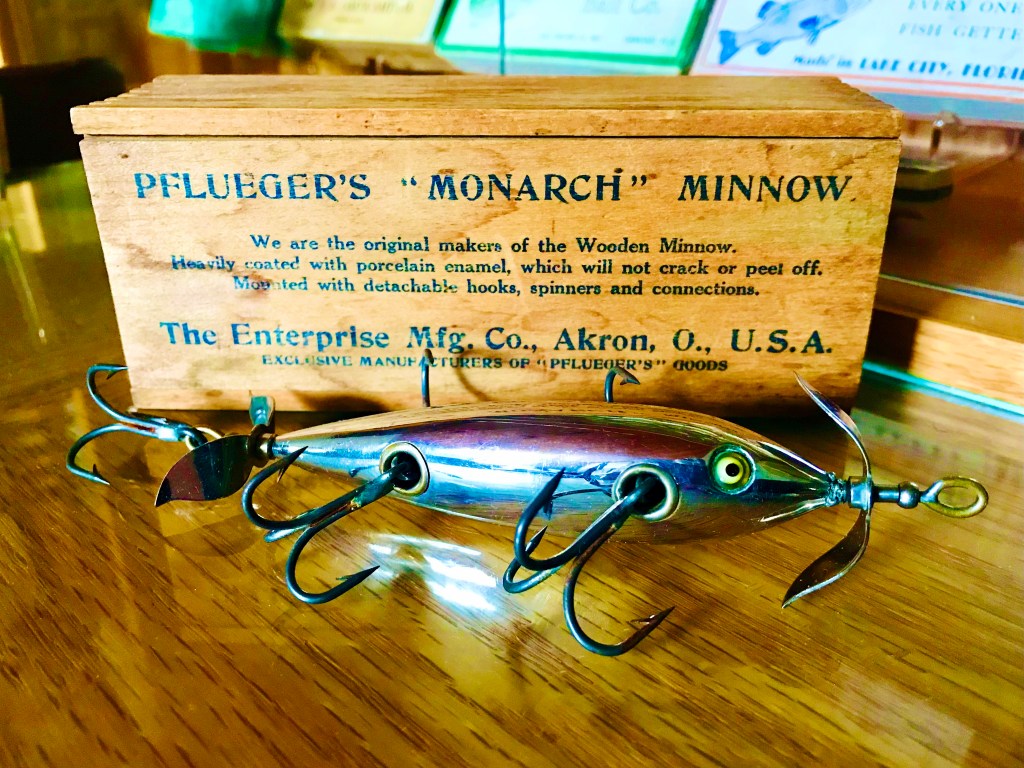
According to Dale Van De Voort’s reference, The Pflueger Book, the Metalized Monarch Minnow was introduced by the Enterprise Manufacturing Company in 1910. Shaped from wood and heavily plated, they were packaged in wooden slide-top boxes like this one, as well as two-piece, maroon-colored cardboard versions. Apparently their highly reflective finish was effective at fooling fish, as they remained in Pflueger’s product line for decades.

This version of the five-hook Underwater Minnow was introduced by South Bend Bait Company in 1912. It’s finished in “shaded white” and features white iris glass eyes and tandem, unmarked props. It is the fourth version of the Underwater Minnow, which was catalogued in 18 different colors. It’s paired with a correct and ultra-rare, second-version maroon box, also from 1912.
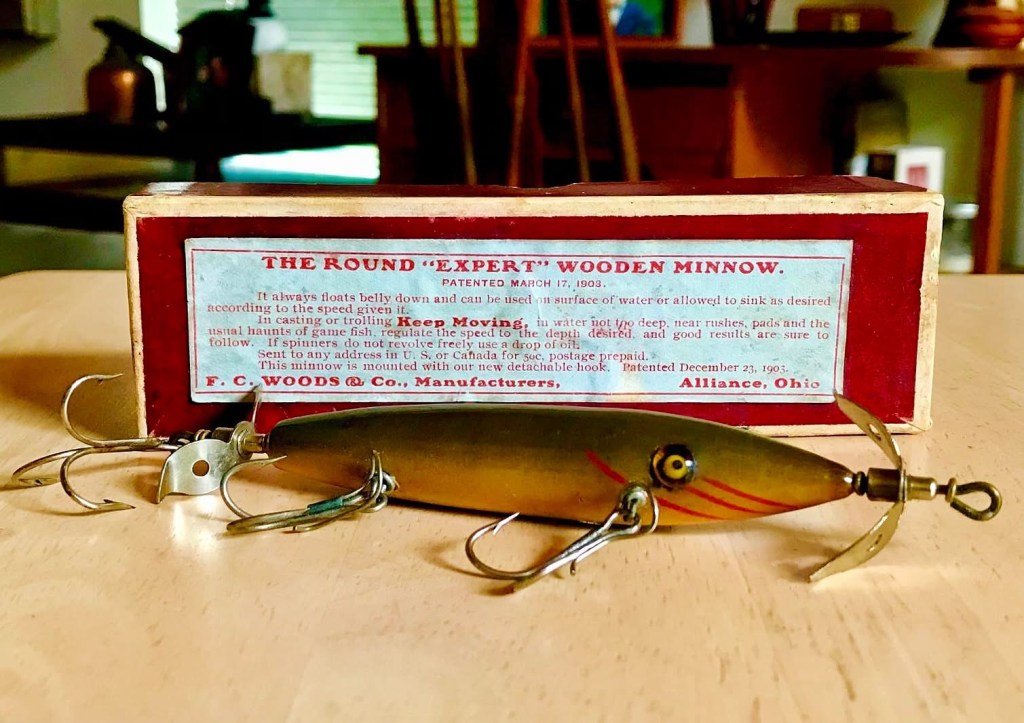
Offered as an economical option to F. C. Woods’ premier line of Expert Minnows, the Round Expert was introduced sometime prior to 1907. It remained in the product line even after ownership transitions to J. L. Clark and eventually Fred Keeling. The example shared here comes in an olive-green back with faint orange belly and sweeping red gills. It features white iris glass eyes, twin-holed props and type-2 removable hooks. It’s accompanied by a crisp and correct, maroon cardboard box.

Introduced in 1911, the three-hook No. 700 was a variation of Heddon’s established line of Muskellunge Minnows. Paraphrased from their catalog, “It features two spinners and three large, extra strong hollow-point, nickel-plated hooks … designed to hold the ‘big ones.'” Initial color offerings included green crackleback, sienna crackleback, rainbow and yellow bar perch. Other colors were available through special order. The large white, down-leaping bass boxes were used from 1912 to approximately 1919 and are rarer than the lures themselves.

This compact diving plug was introduced prior to 1920, by the Creek Chub Bait Company of Garrett, Ind. Tagged the “Baby Wiggler,” it’s simply a downsized version of its predecessor — the 100 Wiggler, which is considered the first lure to feature an attached diving bill.
Creek Chub was granted a patent for their airbrush scale pattern, which they later licensed to other manufacturers. This “goldfish” paint scheme is considered by many as the most beautiful color they ever produced.

William “Billy” Eger began his lure production in the late 1920s, in Bartow, Fla. Among his first offerings were painted, wooden frogs featuring bulbous heads with flutes and raised glass eyes. Soon after their introduction, he patented a method of stretching and curing real frog skins over those same wooden bodies. The finished product became so popular, he licensed the process to competitor companies, Shakespeare and Paw Paw.
For the collector, finding Eger frog skin baits isn’t all that difficult. But to find them with glass eyes in pristine condition, in an original box is a feat.

Presented here is a pike-size Chippewa Minnow by Immel Bait Company of Blair, Wis. It’s painted in a beautiful rainbow pattern and features white-iris glass eyes and brilliant red, spiraling prop. It’s paired with an original, correctly-marked box, and inside is a small card from the manufacturer completing the package.
Chippewa Minnows were offered in 1913 and are considered quite scarce, especially when accompanied by a picture box. To find them in pristine condition like this makes them all the more desirable.
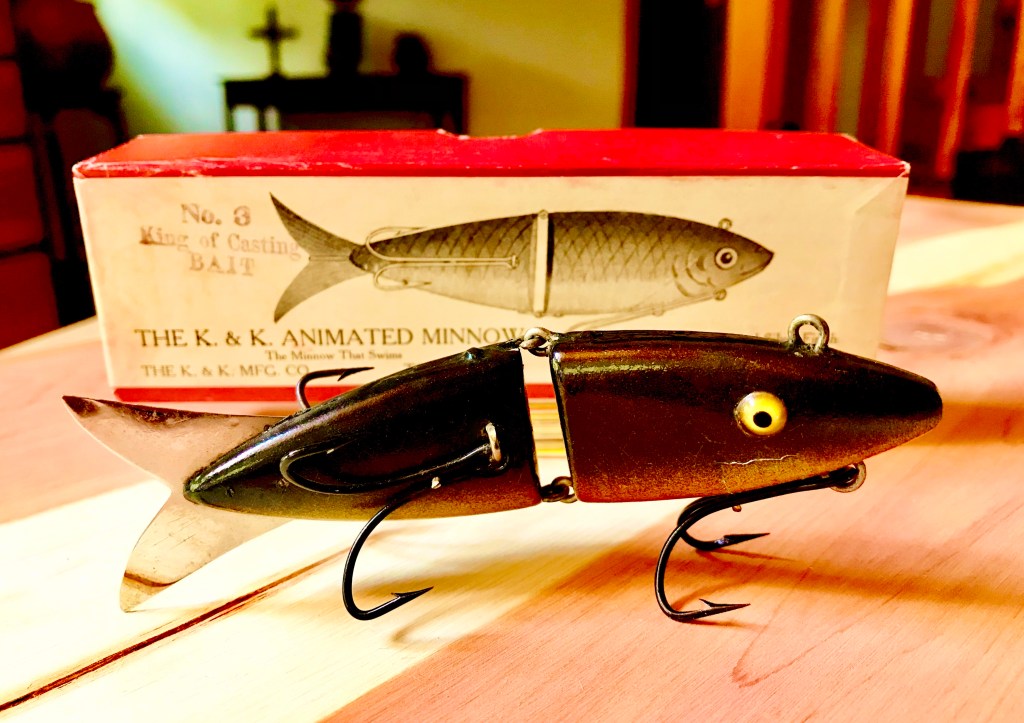
Patented June 25, 1907, the K&K Animated Minnow was the invention of John D. Kreisser. It was produced by K&K Manufacturing Company of Toledo, Ohio, and is considered to be the first articulating wooden lure. Featuring three sets of breakaway tandem hooks, metal tail fin and yellow glass eyes, it’s finished in an eel-like paint scheme with gold belly. Even rarer than the lure is the beautiful picture box, which is stamped “King of Casting Baits.”

The short-lived Heddon No. 400 Bucktail Surface Minnow dates to 1908. It was offered in three colors — rainbow, white with green crackle skullcap and yellow with sienna skullcap. Of the three, rainbow is generally the toughest color to find. Although pictured on the paperwork for other Heddon baits through 1911, boxes specifically designated for the Bucktail Minnow are extremely difficult to find.

This unusual wooden lure was introduced by Fred Paulson of Geneva, Ill., in 1922. It’s distinguished by a divided diving plane, which can be modified to control the lure’s angle or rate of descent and swimming action. Another unusual feature is the reflective metal shield that wraps the belly of the lure, through which the treble hook is anchored.
Most Paulson minnows are fitted with small glass eyes. This example, however, features much larger eyes and was part of a cache acquired from Paulson’s descendants.

This three-hook version of the Expert Minnow was offered in 1907 by the F. C. Woods Company of Alliance, Ohio. Painted in a fiery perch pattern, it features white glass eyes, type-2 removable hooks and tandem-holed props. Accompanied by a correct, one-way slide top box, it is the last version of this classic wooden lure.
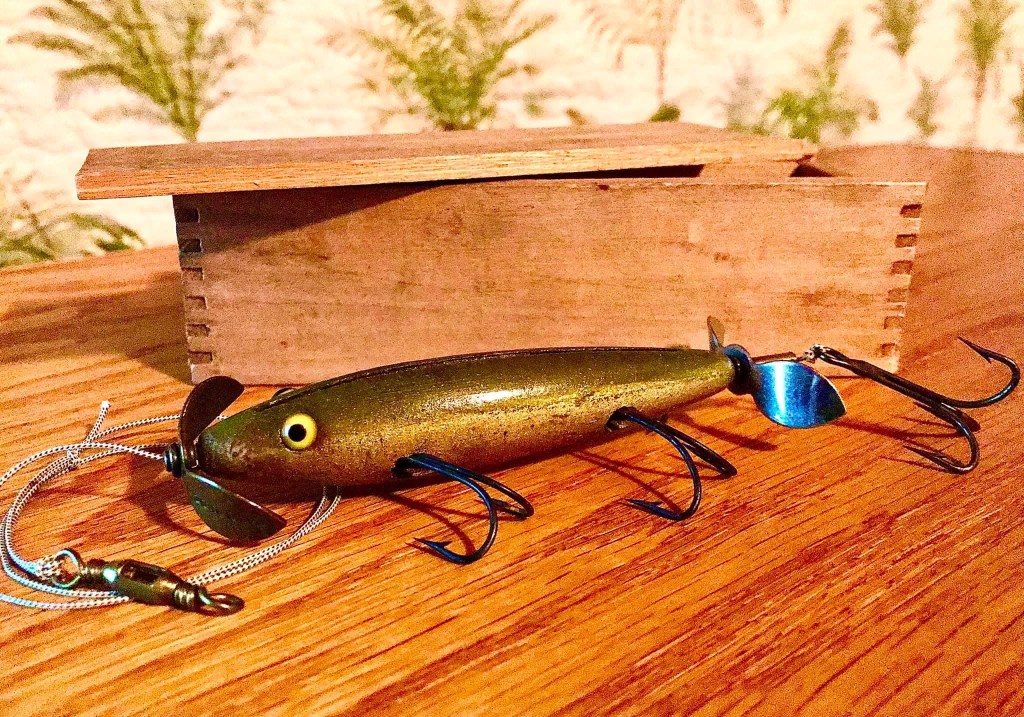
According to Bill Sonnett’s informative article titled “The Rhodes of Kalamazoo,” these unique lures were produced by Jay Rhodes as early as 1903. They are among the rarest of early-American minnows.
This particular example features five detachable hooks, all of which are secured with a single length of corded line. The wooden body is drilled and slotted, and modestly painted in olive green over aluminum. A pair of yoke-colored glass eyes and large, plated brass props complete the package.

According to Murphy & Edmisten’s reference, Fishing Lure Collectibles, Ans B. Decker of Hopatcong, N.J., introduced these simple, yet attractive plugs in 1912. They feature unique tandem props with screw-eye hook hangers and typical Jersey-style hooks. Combined with its original school-bus-yellow box, this combo has strong eye appeal.

This striking 6-inch lure was introduced in 1905, by the William Shakespeare Jr. Company of Kalamazoo, Mich. It’s paired with an ultra-rare, period-correct picture box. Although intended for musky, there’s no doubt these large lures caught their share of black bass.
Part of the renowned Wayne & Lori Edens Lure Collection, this lure and box combo recently sold through Morphy Auctions for an astounding $22,000.

If you would like to learn more on the subject, there are numerous books, websites and clubs dedicated to the hobby. A simple Google search will take you to a number of quality pages, including the National Fishing Lure Collectors Club (NFLCC), Florida Antique Tackle Collectors (FATC) and Old Reel Collectors Association (ORCA). There, you will find many knowledgeable people, all willing to help you with information, advice or an appraisal of your vintage tackle. Photo: Joe Stagnitti




